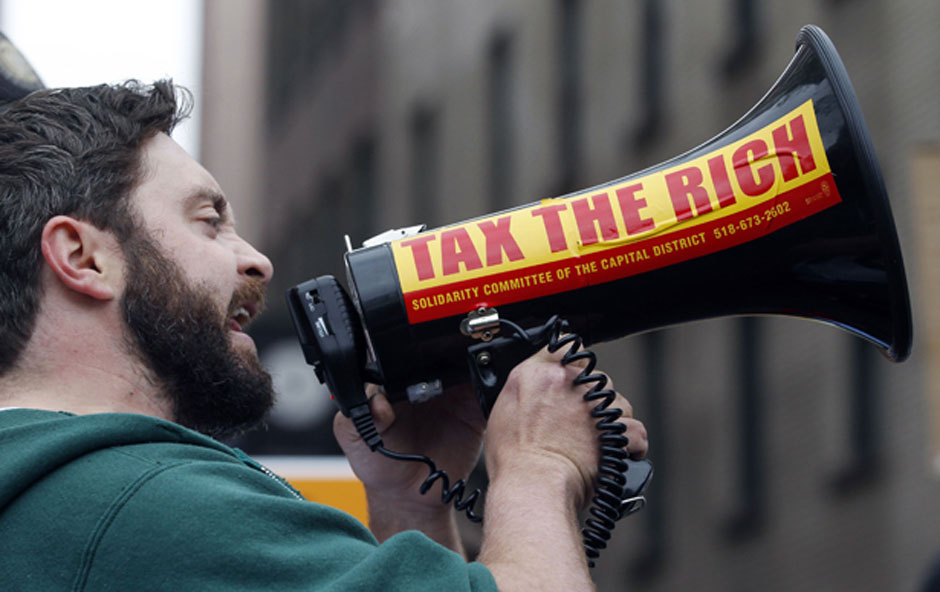
Fans of grand fortune want us to believe that the rich have never paid much more of their income in taxes than they do now. Our actual history says different.
The guardians of our conventional wisdom on taxing the rich messed up, and they know it. They slacked off. They started believing their own tripe. Average Americans, they assumed, would never ever smile on proposals to raise tax rates on the richest among us. After all, the conventional wisdom maintains, those average folks figure that someday they’ll be rich, too.
But now, with tax-the-rich proposals proliferating and polling spectacularly well, the keepers of our bless-the-rich faith are panicking. Their old rhetorical zingers no longer zing.
Higher taxes on the rich as a “penalty on success?” Average Americans today don’t see “success” when they gaze up at America’s top 0.1 percent and see a 343 percent increase in earnings, after inflation, over the past four decades. They see monopoly and outsourcing and insider trading.
Some fans of grand fortune see an opportunity amid this cynicism. They’re realizing that riffing off this cynicism may be the only way to keep taxes on rich people low. Raising tax rates on the wealthy may seem reasonable, their argument goes, but high tax rates on the rich can never actually work out as intended. The rich and their paid help — their accountants and lobbyists — can always end-run them.
So disregard those high tax rates on the rich in effect back in the middle of the 20th century, the argument continues. Those top rates — 91 percent in the 1950s and into the 1960s, then 70 percent through the 1970s — never made much of a difference on how much the wealthy had in their wallets.
“The overall trend is unmistakable,” pronounced John Carlson, co-founder of the right-wing Washington Policy Center, earlier this month. “When rates were much higher, the wealthy sheltered their money and paid a smaller share of the nation’s tax bill.”
In other words, seriously taxing the rich will always be impossible. So why bother even trying?
This you-can’t-tax-the-rich line has appeal — and advocates — far beyond right-wing circles. “Few” wealthy Americans “actually paid” the higher tax rates of the quarter-century that began during World War II, Wall Street financier and former Democratic Obama White House counselor Steven Rattner claimed. Instead, the nation’s wealthiest exploited “tax shelters and tax-avoidance schemes to keep their bill as low as possible.”
In fact, Rattner added, the average effective tax rate on America’s top 1 percent — the share of total income the rich pay in overall taxes — “has remained remarkably stable over the last eight decades.” So what? Why shouldn’t it increase, since the rich game the system?
The reality of the past eight decades has actually been quite a bit more complicated than Carlson and Rattner and their ilk suggest. Yes, America’s rich didn’t actually pay taxes at the exact high rates in effect in the decades right after World War II. But those rich paid much more of their incomes in tax than rich Americans do today.
That reality becomes particularly clear when we go beyond the merely rich top 1 percent and compare the richest of the rich, the top 0.001 percent, of the postwar years with their counterparts now:
- In 1960, the Republican Dwight Eisenhower’s last full year as president, the nation’s top 0.001 percent paid 46 percent of their total incomes in federal income taxes.
- In 2016, the latest year with full IRS stats available, the richest 0.001 percent paid under 23 percent of their total incomes in federal income tax.
In other words, after exploiting every loophole and tax break they could find, the richest of America’s rich back in 1960 paid taxes at over double the rate that the richest of America’s rich pay today. So much for the tax hit on America’s rich remaining “remarkably stable over the last eight decades.”
Most of America’s wealthy in those postwar years actually paid taxes on their total incomes at even higher rates. Back in those years, we had a privileged class within the ranks of the rich. The kingpins of the oil industry enjoyed a set of incredibly generous tax loopholes that no other industry could claim, the notorious oil depletion allowance among them.
Capitol Hill’s power elite, men like House Speaker Sam Rayburn and Senate Majority Leader Lyndon Johnson – both Texas Democrats — zealously protected this preferential treatment for Big Oil. They essentially gave oilmen a super tax-time discount card.
Oilman John Mecom openly boasted he paid just $5 million in taxes on $15 million in annual income — at a time when income over $400,000 was supposed to face a 91 percent tax rate.
In 1954, H.L. Hunt claimed an after-tax income of $54 million. Americans with million-dollar incomes that year paid 54.7 percent of their total incomes in federal income tax. Hunt all by himself pulled down nearly 30 percent of millionaire after-tax income.
That meant, given the special tax breaks oil income enjoyed, that mere “ordinary” millionaires were paying taxes on their total incomes at a rate much higher than 54.7 percent.
And those “ordinary” millionaires resented that tax bite. They campaigned relentlessly to cut it back. Eventually, they succeeded. The top-income-bracket tax rate in the United States has dropped from 91 to today’s 37 percent.
And that’s not even counting where many of the rich really reap rewards, on capital gains, not paychecks. Those are taxed at 20 percent – or were until GOP President Donald Trump and his Republican congressional puppets approved their $1.5 trillion 10-year tax cut for the rich and corporations. Its tax cuts, as small as they are, for the rest of us expire in only a few years.
And what impact has that plummet had on the concentration of America’s income and wealth? Since the middle of the 20th century, the economist Emmanuel Saez calculates, our top 0.1 percent has quintupled its share of the nation’s income.
No wonder the U.S. finishes near the top of the world’s wealthier nations in the income inequality spread between the rich and the rest of us.












Comments